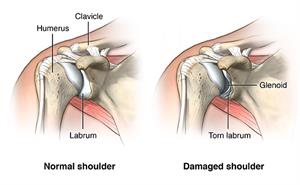Shoulder Dislocation
What is dislocation of the shoulder?
If you have dislocated your shoulder, your upper arm bone (humerus) has moved out of your shoulder joint. This is the most frequently dislocated major joint of your body. Dislocation is often caused by a significant force that separates your shoulder joint's ball (the top rounded portion of your upper arm bone) from your joint's socket (glenoid).

What causes a shoulder dislocation?
Your shoulder can dislocate in several ways, including:
- Forward and downward dislocation. These are the most common types of dislocations. They usually result from falling on your outstretched hand or on your shoulder itself.
- Backward dislocation. This type of dislocation may be caused by a direct blow to the front of your shoulder, or the violent twisting of your upper arm.
Your shoulder can be either partially or completely dislocated. Partial dislocation is when the head of your upper arm is partially out of your shoulder socket. Complete dislocation is when the head of your upper arm is completely out of your shoulder socket.
What are the symptoms of a shoulder dislocation?
The following are the most common symptoms of a dislocated shoulder. However, you may experience symptoms differently. Symptoms may include:
- Pain in your upper arm and shoulder, which is usually worse when you move them
- Swelling
- Numbness and weakness
- Bruising
- Deformity of your shoulder (in a forward dislocation)
The symptoms of a dislocated shoulder may resemble other conditions or medical problems. Always consult your health care provider for a diagnosis.
How is a shoulder dislocation diagnosed?
In addition to a complete medical history and physical exam, diagnostic procedures for a dislocated shoulder may include an X-ray.
How is a shoulder dislocation treated?
Your health care provider determines specific treatment for a shoulder dislocation, based on:
- Your age, overall health, and medical history
- Extent of your injury
- Your tolerance for specific medications, procedures, or therapies
- Expectations for the course of your injury
- Your opinion or preference
Treatment may include:
- Moving the head of your upper arm bone back into your shoulder joint, usually with an anesthetic
- Immobilizing your shoulder with a sling
- Rehabilitation
- Surgery, if nonsurgical measures do not restore stability
Can a dislocated shoulder be prevented?
Maintaining muscle strength and flexibility can help prevent shoulder dislocations. Once your shoulder is dislocated, physical therapy may help prevent you from dislocating it in the future. Through restoring your shoulder’s range of motion and physical strength, your risk for dislocation decreases.
How is a shoulder dislocated managed?
Once your shoulder has been placed back into the socket joint, your health care provider may advise you to keep your shoulder immobilized in a sling or other device for several weeks after treatment. Resting and applying ice to the affected area several times a day will help your pain and swelling diminish.
After your pain and swelling subside, you may need to do some rehabilitation exercises to help restore your shoulder’s range of motion and strengthen your muscles.
When should I call my health care provider?
You should contact your health care provider if you have the following symptoms:
- Swelling and/or pain in your shoulder, arm, or hand that worsens
- Your arm or hand turns purple
- You have a fever
Key points
- Dislocation of your shoulder means your upper arm bone (humerus) has come out of your shoulder joint.
- Your shoulder can dislocate in several ways, including: forward and downward dislocation and backward dislocation.
- A dislocated shoulder is very painful.
- If you had a dislocated shoulder in the past, you are at greater risk for having it occur again.
- After you have relieved your initial pain, rehabilitation exercises will help you prevent future dislocation.
- Maintaining muscle strength and flexibility can help prevent shoulder dislocations.
Next steps
Tips to help you get the most from a visit to your health care provider:
- Before your visit, write down questions you want answered.
- Bring someone with you to help you ask questions and remember what your provider tells you.
- At the visit, write down the names of new medicines, treatments, or tests, and any new instructions your provider gives you.
- If you have a follow-up appointment, write down the date, time, and purpose for that visit.
- Know how you can contact your provider if you have questions.
Online Medical Reviewer: Fraser, Marianne, RN, MSN
Date Last Reviewed: 1/29/2014
© 2000-2016 The StayWell Company, LLC. 780 Township Line Road, Yardley, PA 19067. All rights reserved. This information is not intended as a substitute for professional medical care. Always follow your healthcare professional's instructions.